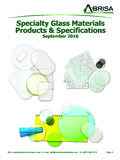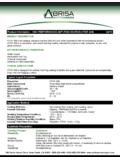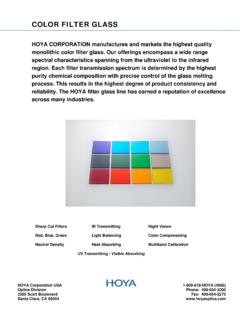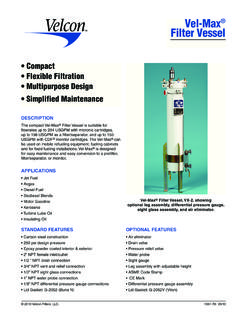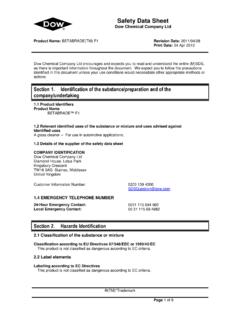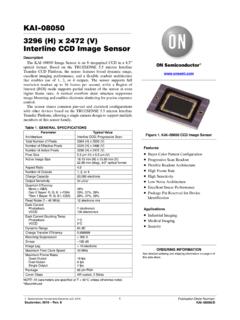Transcription of Abrisa TechnologiesAbrisa Technologies Guide to …
1 200 South Hallock Drive, Santa Paula, CA 93060 (805) 525-4902 FAX (805) 525-8604 Abrisa TechnologiesAbrisa Technologies Guide to glassguide to glass Optical PropertiesOptical Properties Light & ColorLight & Color Glare ReductionGlare Reduction glass StrengtheningGlass Strengthening January 2013 Product Information: Guide to glass - Optical Properties (Types - Light & Color - Glare Reduction & glass Strengthening) 01/13 200 South Hallock Drive, Santa Paula, CA 93060 (805) 525-4902 FAX (805) 525-8604 Types of glass & Their Thermal Properties Different types of glass possess different qualities depending upon their chemical makeup and how they have been pro-duced. Choosing the right type of glass for your application also means understanding the different physical properties each different type of glass possesses.
2 Thermal Properties glass is measured in a variety of factors which greatly affect your choice of glass . The Coefficient of Thermal Expansion (CTE) is the expansion measurement of glass as temperature is raised. This is an important factor to consider when placing glass in a frame since glass expands much less than most metals and plastics, and may cause breakage upon cooling. The Thermal Conductivity is the ability to conduct heat through the glass or away from the heat/light source. This is important when considering glass as a view port exposed to high temperatures or for high infrared applications. Each type of glass has a Maximum Operating temperature and Thermal Shock rating. These will Guide the choice of glass depending on the amount of heat glass will withstand, and how it cools after glass is subjected to rapid change in temperature.
3 glass may be strengthened to change these thermal properties by Heat Strengthening, Heat Tempering, or Chemically Strengthening (For more information go to glass Strengthening section of this product information Guide ). Optical Properties There are several important measurements when determining the amount of light passing through glass . The refractive Index determines how much a light wave is bent when entering or leaving the surface of the glass . This is important in producing certain optical devices or effects, such as lenses. The Dispersion measures the separation of light into its component colors, such as a prism dispersing white light into a color band or a rainbow effect. The Transmission meas-ures the amount of light passing through the glass material, and its opposite, Reflectivity which measures the return of light from the surface.
4 The Absorption property is the amount of light energy converted to heat within the glass that is not transmitted nor reflected. Tinted materials will absorb more light than clear materials. (For More information go to Light & Color section of this information Guide ). Chemical Properties All soda-lime type glasses and some borosilicate glasses contain sodium or alkali metal ions. Prolonged exposure to liquids or va-por, such as water, will cause the sodium/alkali ions to migrate to the surface of the glass called Sodium or Alkali Leaching. This can cause cloudiness or haze on the surface of the glass . Porous coat-ings may also incur this phenomenon, causing a disruption of the bond between the coating and the glass surface. In high humidity or critical surface applications, this must be considered when speci-fying the material.
5 Placing a barrier coating, such as silicon diox-ide, on the glass will limit the amount of reaction. The Acid resis-tance and Alkali Resistance measure the time it takes to remove a layer of specified thickness for each test. Product Information: Guide to glass - Optical Properties - (8 Pages) (Types - Light & Color - Glare Reduction & glass Strengthening 01/13 200 South Hallock Drive, Santa Paula, CA 93060 (805) 525-4902 FAX (805) 525-8604 Types of glass & Their Thermal Properties (cont.) Electrical Properties When choosing a glass for electrical or electronic applications, there are several characteristics to consider. The Vol-ume resistivity is the resistance in ohms between opposite faces of a centimeter cube of the glass tested.)
6 This is impor-tant when glass is used as an electrical insulator. The Dielectric Constant of a glass is the ratio of energy stored in a condenser with the glass as the dielectric, compared with the energy stored in the same condenser with air as the di-electric. This measures the ability of a glass to store electrical energy, and varies with the frequency of the voltage ap-plied to the condenser. This is important when the glass is used as a substrate for electrical or electronic devices. Sur-face Resistivity is the ratio of the potential gradient parallel to the current along its surface, to the current per unit width of the surface. This method is used to measure the conductivity of coated glass . Mechanical Properties The mechanical properties of glass determine the amount of stress a glass can withstand.
7 Stress is defined as the per-pendicular force per unit area applied to an object, in a way that compresses (compressive stress) or stretches (tensile stress) the object. Strength of the ability of glass to withstand these stresses. Non-strengthened glass materials have relatively low tensile strength yet high compressive strength. Therefore, most glass breakage is due to tensile stress fail-ure. Mechanical properties are measured in a variety of ways: Modulus of Rupture (MOR) test measures the bending or flexural strength; Shear Modulus measures the amount of shearing or twisting forces a glass can withstand; Knoop Hardness Number (KHN) measures the hardness of glass ; Density is the mass value per unit of volume Specific gravity is the ratio of the density of the glass to the density of water.
8 Product Information: Guide to glass - Optical Properties (Types - Light & Color - Glare Reduction & glass Strengthening 01/13 200 South Hallock Drive, Santa Paula, CA 93060 (805) 525-4902 FAX (805) 525-8604 Light & Color Understanding Light & Color Understanding how to control light and color requires understanding the light spectrum. Light is how we describe a form of electromagnetic energy that interacts with chemicals in the retina and generates an electrical impulse, giving rise to complex neural signals ending with the perception that we term sight. The amount of electromagnetic energy that is de-tected and viewable through the material is defined as the transmission of the glass . Light is a portion of the electromagnetic spectrum.)
9 For glass purposes, we usually define light as that portion of the spec-trum from the ultraviolet range through the visible range and then through the infrared range. Our eyes permit the dis-crimination of many individual wavelengths or combinations of wavelengths we call colors. See the light spectrum to the right: When light encounters elements in the glass that are small relative to the light wavelengths, then the shorter wave-lengths are scattered much more than the longer. This is the reason a cloudless sky is blue and the overhead sun is yellow: the blue light from the sun is scattered by air molecules in the atmosphere much more than the light at the red/yellow end of the spectrum. At sunset the sun s rays must traverse a longer path through the atmosphere to an observer than earlier in the day so that s only the relatively non-scattered red rays will reach an observer and explains the red colors of sunset.
10 This is known as Rayleigh scattering. Further, without an atmosphere the sky would be black in daytime. When the major part of the light is transmitted through the glass without scattering or absorption, the substance is said to be transparent. When most of the light entering glass is absorbed within it, the glass is said to be opaque. In some glasses, an electron in the glass may absorb a photon of one particular wavelength, and release and transmit another longer wavelength and lower energy photon; this is called fluorescence. Note that selective absorption of particular wavelengths gives rise to the transparency and colors seen in many precious gems or colored glass . Controlling Light & Color with Coatings & Filters Controlling light and colors with coatings and filters interact with the characteristics of reflection, refraction, and interfer-ence of the light wave passing through glass .
